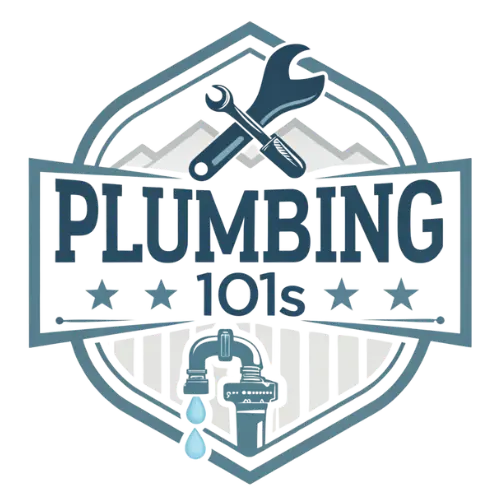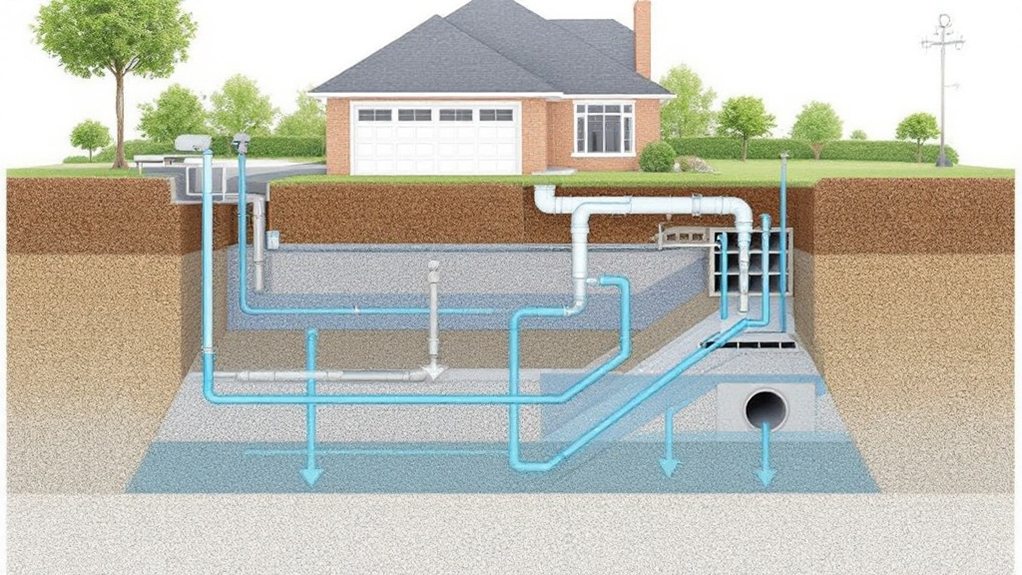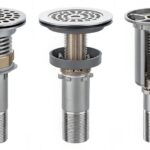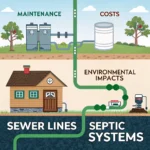Drainage systems consist of essential surface and subsurface components that manage water flow around properties. Surface elements include graded channels, catch basins, and open drains, while subsurface solutions utilize French drains with perforated pipes and gravel beds. Key materials encompass PVC piping, concrete channels, and filtration fabrics, all working together to redirect water effectively.
Proper installation requires thorough property assessment, including soil composition analysis and land grade evaluation, typically maintaining a 2-5% slope for ideal water movement. Regular maintenance of these components, combined with sustainable approaches like permeable surfaces, guarantees long-term system effectiveness.
Understanding these foundational elements opens the door to mastering advanced drainage solutions.
Highlights
- Surface water management systems include graded channels, catch basins, and open drains to protect structures from water damage.
- Subsurface drainage networks use perforated pipes, gravel, and planned trench systems to redirect water below ground level.
- Essential components include gutters, downspouts, drainage pipes (PVC, clay, concrete), and catch basins for efficient water collection.
- Property assessment requires soil testing, land grade evaluation, and water flow pattern analysis for effective system design.
- Regular maintenance involves cleaning gutters, inspecting catch basins, monitoring pipes, and addressing drainage issues promptly.
Surface Water Management Fundamentals
While many property owners focus on indoor plumbing, surface water management plays an equally essential role in protecting structures and landscapes from water damage. Effective drainage systems incorporate multiple components that work together to remove excess water from properties during and after rainfall events.
Key Components of Surface Water Management:
- Graded channels and swales that direct water flow
- Strategically placed catch basins to collect runoff
- Open drains that transport water to designated outlets
The success of surface water management relies heavily on proper system design that considers natural topography and creates intentional flow patterns. Water must be guided along carefully planned routes, preventing accumulation in low-lying areas that could lead to flooding or soil erosion.
Maintenance Requirements:
- Regular inspection of drainage components
- Removal of debris from gutters and catch basins
- Monitoring of water flow patterns
- Assessment of system effectiveness during rainfall
Professional drainage systems should accommodate local rainfall patterns while protecting property integrity. Through careful implementation of surface water management strategies, property owners can greatly reduce water-related risks and maintain ideal site conditions throughout the year.
Subsurface Drainage Solutions
Beneath the surface lies a crucial component of thorough drainage systems – the subsurface drainage network. These specialized systems, commonly known as French drains, effectively collect runoff water and redirect it away from waterlogged areas through a network of perforated pipes.
Key Components and Installation:
- Perforated pipes surrounded by gravel or rock aggregate
- Carefully planned trench networks following land gradients
- Proper filtration materials to prevent sediment buildup
The primary function of subsurface drainage systems is to improve drainage in areas with poor natural water movement, particularly in clay-rich soils. When properly installed, these systems intercept excess water at the root zone, preventing soil saturation and promoting healthy plant growth.
Maintenance Requirements:
- Regular inspection of pipe integrity
- Removal of accumulated debris and sediment
- Monitoring of water flow patterns
- Clearing of any root intrusions
For ideal performance, installation must consider soil composition, terrain slope, and local rainfall patterns. The system’s efficiency depends on proper planning and regular maintenance, ensuring long-term functionality and preventing costly drainage issues.
Professional installation is often recommended due to the precise grading requirements and technical expertise needed.
Essential Components and Materials
A well-designed drainage system relies on several essential components and materials working in harmony to effectively manage water flow. The primary elements include gutters and downspouts, which collect rainwater from roofs and direct it away from building foundations, preventing potential structural damage and soil erosion.
Key components include drainage pipes, which serve as the main conduits for water transport, available in various materials such as PVC, clay, and concrete. Catch basins, strategically placed throughout the system, collect sediment and debris while allowing water to flow freely, maintaining system efficiency and reducing maintenance requirements.
French drains, consisting of perforated pipes surrounded by gravel, provide essential subsurface drainage for areas prone to water accumulation.
For ideal drainage system performance, consider these critical factors:
- Material selection based on soil type, water volume, and environmental conditions
- Proper sizing of components to handle maximum expected water flow
- Strategic placement of catch basins and access points for maintenance and cleaning
These components work together to create a thorough drainage solution that effectively manages water flow while protecting property integrity.
Property Assessment and Planning
A thorough property assessment begins with analyzing soil composition through testing, which reveals drainage capacity and helps determine whether natural infiltration or engineered solutions are needed.
The evaluation of land grade, measured as the change in elevation over distance, indicates how water naturally flows across the property and identifies potential problem areas where pooling might occur.
Understanding water flow patterns during rainfall events allows property owners to map drainage paths and strategically place collection points, catch basins, or French drains where they will be most effective.
Soil Type Analysis
Proper soil type analysis serves as the foundation for effective drainage system design and implementation. Understanding the characteristics of your soil helps determine the most suitable drainage solutions and prevents future water accumulation issues. Through thorough testing and assessment, property owners can make informed decisions about drainage system components and installation methods.
Key factors in soil analysis include:
- Percolation Rate Testing: Measures how quickly water moves through soil layers, helping determine if natural drainage is sufficient or if additional interventions are needed.
- Soil Composition Assessment: Evaluate the percentages of sand, silt, and clay to predict water retention and movement patterns.
- Water-Holding Capacity Analysis: Determines how much moisture the soil can retain before becoming saturated.
- Clay: heavy soils typically require more extensive drainage interventions, such as subsurface pipes and gravel beds, while sandy soils may function well with simpler surface solutions.
Regular monitoring of soil conditions guarantees drainage systems remain effective over time, as soil composition can change due to erosion, compaction, and organic matter decomposition.
Professional soil testing services can provide detailed analysis reports, enabling precise drainage system customization for peak performance.
Land Grade Evaluation
Surveying the natural contours of your property, land grade evaluation forms a critical component of effective drainage system design. This assessment process measures how water will flow across the terrain and identifies potential problem areas where water might collect or cause erosion.
Proper land grade evaluation involves several key elements:
- Slope Measurement: Ideal grades fall between 2% and 5% for effective water runoff, ensuring water moves away from structures without causing soil erosion.
- Topographic Mapping: Using detailed elevation maps to analyze natural drainage patterns and identify low points requiring additional attention.
- Regulatory Compliance: Local building codes often specify required grading standards to prevent water-related issues affecting neighboring properties.
Best Practices for Grade Assessment:
- Conduct thorough site surveys before drainage system installation.
- Document existing water flow patterns during rainfall.
- Mark areas prone to standing water.
- Consider seasonal changes in water movement.
Professional grade evaluation greatly impacts drainage system performance, reducing future maintenance requirements and preventing costly water damage.
Water Flow Patterns
Through careful observation of water flow patterns, property owners and drainage professionals can develop effective strategies for managing surface and subsurface water movement. Understanding how water travels across a property enables the implementation of effective drainage systems that prevent flooding and water damage to structures.
The assessment of water flow patterns requires evaluation of several key factors:
- Topographical Features: Analyze natural slopes, depressions, and elevations that influence how water moves across the property, identifying areas where water naturally collects or channels.
- Soil Composition: Examine soil types to determine permeability rates and infiltration capacity, which directly affect how water flows through the ground.
- Natural Drainage Points: Document existing water pathways and discharge points that can be integrated into planned drainage systems.
To properly manage water movement, professionals must consider both surface runoff and subsurface flow patterns. This thorough approach helps determine the ideal placement of drainage components such as catch basins, French drains, or surface channels.
Installation Best Practices
Successful drainage system installation begins with a thorough site assessment that evaluates soil composition, water patterns, and terrain features to determine ideal system placement.
The selection of appropriate materials, including properly sized PVC or corrugated pipes, filter fabric, and gravel aggregate, forms the foundation of a reliable drainage solution.
Professional grading techniques must establish precise slopes, typically 1-2% grade per linear foot, to guarantee water flows away from structures and towards designated collection points while preventing erosion and water accumulation.
Site Assessment and Planning
Before implementing any drainage solution, a thorough site assessment serves as the foundation for an effective system design. The evaluation process requires careful analysis of multiple property characteristics, including soil composition, topographical features, and existing water flow patterns, to determine ideal drainage solutions.
Professional site assessment involves a systematic examination of key factors that influence how water moves across the property. This extensive approach helps identify potential problem areas and natural drainage opportunities that can be integrated into the final design.
Key assessment components include:
- Property Analysis: Measure lot dimensions, evaluate soil permeability through testing, and document existing structures that may impact water flow.
- Climate Assessment: Review local rainfall data, seasonal weather patterns, and historical flooding records to determine system capacity requirements.
- Regulatory Compliance: Research local building codes, environmental regulations, and permit requirements that govern drainage installations.
A methodical site evaluation enables engineers and contractors to control water flow effectively while considering both immediate drainage needs and long-term environmental impacts.
This planning phase establishes the framework for selecting appropriate materials, determining the ideal placement of drainage components, and developing maintenance schedules.
Proper Material Selection
Building upon a thorough site assessment, proper material selection stands at the core of any effective drainage system installation. The choice of durable materials directly impacts system longevity and performance, requiring careful consideration of local conditions and specific drainage requirements.
| Material Type | Primary Application | Key Benefits |
|---|---|---|
| PVC Pipe | Underground Drainage | Corrosion-resistant, Long lifespan |
| Corrugated Pipe | Subsurface Systems | Flexible, Easy installation |
| Concrete Channels | Surface Drainage | High strength, Weather-resistant |
| Perforated Pipe | French Drains | Enhanced water collection |
| Graded Gravel | Filtration Layer | ideal water flow, Prevents clogging |
Critical considerations for drainage systems include:
- Material compatibility with soil composition
- Load-bearing requirements for surface installations
- Climate resistance properties
- Maintenance accessibility
- Cost-effectiveness over system lifespan
When selecting materials, prioritize those that offer proven durability in similar applications. PVC and corrugated pipes excel in subsurface applications, while concrete channels provide robust surface solutions. The integration of properly graded aggregate materials, such as crushed stone or gravel, guarantees ideal water flow and system efficiency, particularly in French drain installations.
Grading and Slope Control
Effective drainage system installation fundamentally depends on precise grading and slope control techniques. The process requires maintaining a minimum 2% slope, or 1/4 inch per foot, directing water runoff away from structural foundations to prevent water accumulation and potential damage.
Professional grading techniques, combined with strategic placement of swales and ditches, create efficient pathways for excess water movement.
Key implementation strategies for optimal drainage include:
- Establish proper surface grading by carefully measuring slope angles, guaranteeing consistent decline away from buildings while maintaining soil stability through compaction.
- Install swales or drainage channels at strategic locations, particularly in areas where water naturally collects, creating designated paths for runoff management.
- Incorporate native vegetation and erosion control measures along graded surfaces to reinforce soil structure and enhance natural drainage patterns.
For properties with significant elevation changes, retaining walls serve as fundamental components in managing water flow and preventing soil displacement.
Regular maintenance of graded surfaces remains essential, including removal of accumulated debris and periodic inspection of drainage pathways to guarantee the continued effectiveness of the system’s water management capabilities.
Regular Maintenance Guidelines
Maintaining a well-functioning drainage system requires consistent attention and periodic upkeep throughout the year. Regular maintenance of these systems plays a vital role in preventing water-related damage and ensuring peak performance of drainage components.
Key Maintenance Tasks:
- Clear gutters and downspouts annually, removing leaves, twigs, and sediment that can impede water drainage.
- Inspect catch basins and drains for buildup, cleaning them as needed to maintain proper flow.
- Monitor pipes and connections for signs of damage, including cracks, leaks, or joint separation.
- Address pooling water immediately, as it often indicates underlying drainage issues.
Homeowner Responsibilities:
- Conduct visual inspections after heavy rainfall.
- Remove vegetation growing near drainage structures.
- Document any recurring issues for professional assessment.
- Schedule professional maintenance when problems exceed DIY capabilities.
System Assessment Indicators:
- Standing water in the yard or basement.
- Slow-draining fixtures or backed-up systems.
- Unusual odors from drains.
- Foundation dampness or watermarks.
Professional intervention is recommended for complex issues, while routine maintenance tasks can typically be managed by property owners following proper safety protocols and guidelines.
Sustainable Drainage Approaches
Creating sustainable drainage solutions has become increasingly essential as communities face growing environmental challenges and water management concerns. Modern sustainable drainage approaches integrate multiple technologies and natural systems to manage water effectively while protecting the environment.
Key components of sustainable stormwater management include permeable surfaces that allow water infiltration, bioretention systems that filter pollutants, and smart monitoring technologies. These systems work together to reduce flooding risks and promote water conservation through natural processes.
Three primary benefits of sustainable drainage systems:
- Enhanced groundwater recharge through permeable paving and rain gardens, which allow natural water filtration.
- Reduced urban heat island effects and improved energy efficiency through green roof installations.
- Decreased municipal water dependency through rainwater harvesting and storage systems.
Advanced solutions like bioswales and rain gardens utilize native vegetation to filter contaminants while supporting local ecosystems.
Smart drainage systems, equipped with moisture sensors and monitoring devices, enable precise water management through real-time data collection and analysis. These technologies, combined with green infrastructure elements, create thorough water management solutions that benefit both communities and the environment.
Common System Issues
Despite regular maintenance efforts, drainage systems frequently encounter several essential issues that can compromise their functionality and efficiency. Common problems include blockages caused by accumulated debris, sediment buildup, and invasive tree roots, which often result in water pooling and reduced system performance.
Key indicators of drainage system failure include:
- Water stains appearing on foundation walls
- Recurring basement flooding events
- Persistent sewage odors from trapped waste
- Soil erosion around property perimeters
Downspout and gutter systems present additional challenges, as improper installation or inadequate maintenance can lead to overflow situations. When water isn’t properly directed away from structures, it frequently causes deterioration of roofing materials and foundation damage, ultimately leading to costly repairs.
Professional Assessment Guidelines:
- Conduct monthly visual inspections of drainage components
- Monitor water flow patterns during rainfall
- Document any signs of system backup or overflow
- Schedule professional cleaning services bi-annually
Early detection through regular system evaluation remains vital for preventing extensive damage and maintaining peak drainage function. Property owners should implement consistent inspection routines to identify potential issues before they escalate into major system failures.
Professional Services and Support
Professional drainage services play an essential role in preserving the integrity and functionality of residential and commercial water management systems. Expert evaluation and regular maintenance guarantee peak performance while preventing costly repairs through early detection of potential issues.
Companies specializing in drainage systems, such as Frati Plumbing, offer extensive assessments that identify vulnerabilities and verify compliance with local regulations.
Professional maintenance services typically include:
- Thorough inspection of drainage components, including gutters, downspouts, and catch basins, to identify blockages or damage.
- Professional cleaning and debris removal from critical system components, ensuring proper water flow and preventing backup.
- Detailed assessment of pipe conditions using specialized equipment to detect cracks, corrosion, or other structural concerns.
Annual professional inspections, ideally scheduled before seasonal rains, are vital for maintaining system efficiency and preventing emergencies.
These services not only extend the lifespan of drainage systems but also protect properties from water-related damage. Through regular professional maintenance, homeowners can guarantee their drainage systems remain functional and compliant with local standards, ultimately saving time and resources while maintaining property value.
Frequently Asked Questions
What Are the Four Major Components of the Drainage System?
The four major drainage system materials include gutters for roof collection, downspouts for vertical water transport, various drainage pipe types for water conveyance, and drains for efficient collection, requiring regular drainage maintenance tips implementation.
What Are the 4 Characteristics of a Drainage System?
The four key characteristics of a drainage system are: proper flow capacity, ideal drainage efficiency, adequate soil permeability for water absorption, and effective water quality management through filtration and sediment control.
What Are the Components of Surface Drainage System?
Surface drainage system components include engineered drainage system materials like channels, ditches, levees, and grassed waterways, designed for effective surface water management while minimizing environmental impact through proper grading and water flow control.
What Are the General Principles of Drainage System?
Effective drainage design relies on proper water management, utilizing natural slopes, considering soil permeability, and ensuring water flows away from structures. Systems must prevent pooling while facilitating efficient water collection and disposal.



